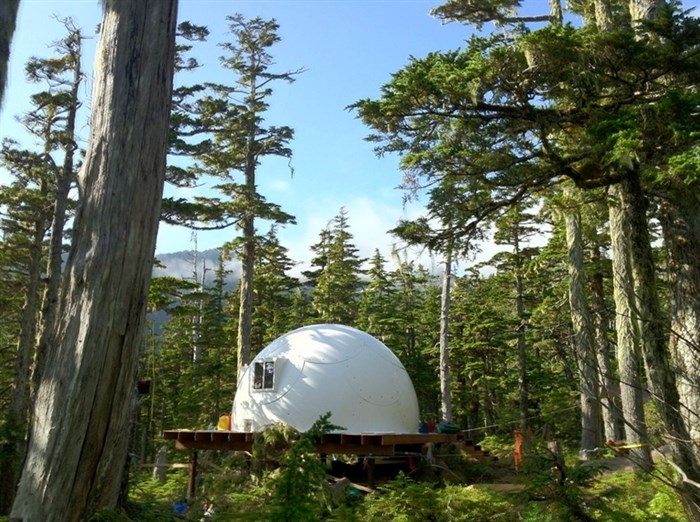Futuristic micro-home communities may be answer to housing crisis in Thompson-Okanagan

With new single-family houses selling for $1 million or more in the Thompson-Okanagan region, the dream of house ownership is out of reach for many.
But Jean-Marc La Flamme is working with CoHo BC through his Future Villages project to make it a $50,000 reality.
Sure, that means living in a small space and sharing the land with others, but it’s starting to become a reality in three Kootenay communities with groups also forming in Osoyoos, Peachland and north of Kamloops.
The key to this happening now is the success of CoHo BC, a Lower Mainland based organization that supports group ownership of housing and even started a matchmaking service two years ago.
READ MORE: Housing co-ownership matchmaking service advancing in Kamloops, Okanagan
“I’ve tried unsuccessfully to do this for years with local lawyers but it’s not until now, since the pandemic, that this group, CoHo BC, has really taken off,” La Flamme told iNFOnews.ca.
“The co-ownership agreement is the most important legal structure. It’s the reason, in the past, you didn’t have a high success rate with intentional communities or eco-villages.
"They’ve been around for eons. It’s really for a lack of actually being organized. Now there is a new level of organization with these co-ownership agreements.”
Cooper Creek is the furthest ahead of the half-dozen projects La Flamme is helping nurture into life.
In that case, an elderly couple has two parcels of land, one of which they are selling into a micro-home community as partners.
As more people come in, they buy out the owners.
It’s expected to have 20 homes but could expand into a second phase on a neighbouring property to 50 homes and 100 people.
The Rossland/Regional District of Kootenay Boundary situation is someone wanting to sell their property and move on, while Slocan Valley is a situation where the owner wants to also live in the micro-home community.
“Every project is totally different, just like any real estate deal,” La Flamme said. “I hope, at some point, this is going to be super-easy for people to understand but because it’s so new, there are different permutations.
"I hope we will see a future where it’s literally turnkey. This is the model. Pay $50,000 and you get your house and your land.”
In Kaslo, there's a local builder who's making wooden tiny homes, but La Flamme is also recommending two other modular home builders to consider. Intershelter makes fibreglass domes and Bunkie Life builds cottages out of Ontario.
“The direction we’re going with housing is super light, super affordable and super disaster-proof, that is the goal,” La Flamme said.
"The path between now and then, the path that we’re recommending, is that people choose the model that they’re financially able to afford, based on the understanding that there’s going to be a huge selection of housing that is climate resilient in the very near future.”
By building small, and well within budgets, even the worst forest fires aren’t going to be disastrous, he suggested. And sharing the price of land mitigates the financial risk.
The tiny homes are in the 200-300 square foot range, but that can just be the start.
“The focus for most progressive housing companies is modular,” La Flamme said “You start with one. You connect another one through the doorway. It turns into a Lego, essentially.”
The shells cost about $15,000. Then there's the electrical, plumbing and other add-ons that brings the price up to about $20,000.
Each of the half dozen projects La Flamme is mentoring is different.
In the Thompson-Okanagan region one is a former RV resort a group wants to modify into micro-homes.
“Another group has a big chunk of private land and has run up against the bureaucracy of trying to build a traditional development and they’re sick and tired, so they want to build a micro-home community just to get it going,” La Flamme said.
“I only pick projects that are not going to run up against bureaucracy, so they’re in areas away from built areas that have little to no zoning. That’s most of the West Kootenays, which is why we have such a good area here.”
There are some key elements needed to get these sites to work.
“Every project needs a leader,” La Flamme said. “I can’t be that leader. In Rossland, it has a group but it doesn’t have a leader, a champion. In the Slocan, they have a leader but they still have to get educated in how to conduct all of this so they have to work with myself and CoHo BC and learn all of this.
“For now, there’s a lot of hand-holding. It’s not for a lack of demand it’s just literally because people need to spend many months learning about this and forming the group and finding the right people and, ultimately, raising a bit of capital. And, yeah, the money thing isn’t a problem. People are selling their homes at a great price. They’ve got money in the bank.”
To find out more about Future Villages, go here.
To learn more about CoHo BC, go here.
- This article was updated at 2:55 p.m. on March 26, 2024, to correct some spelling.
To contact a reporter for this story, email Rob Munro or call 250-808-0143 or email the editor. You can also submit photos, videos or news tips to the newsroom and be entered to win a monthly prize draw.
We welcome your comments and opinions on our stories but play nice. We won't censor or delete comments unless they contain off-topic statements or links, unnecessary vulgarity, false facts, spam or obviously fake profiles. If you have any concerns about what you see in comments, email the editor in the link above. SUBSCRIBE to our awesome newsletter here.



